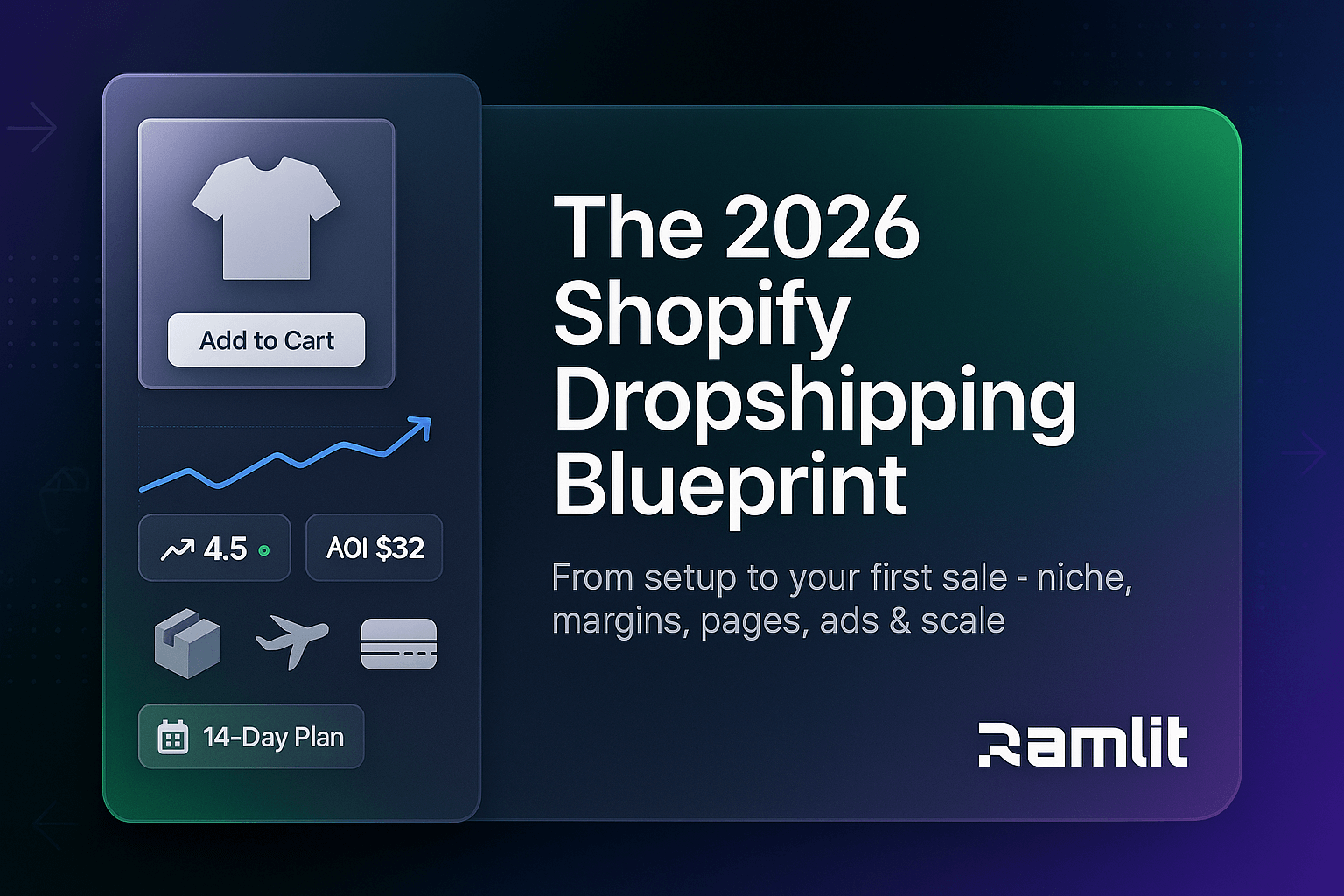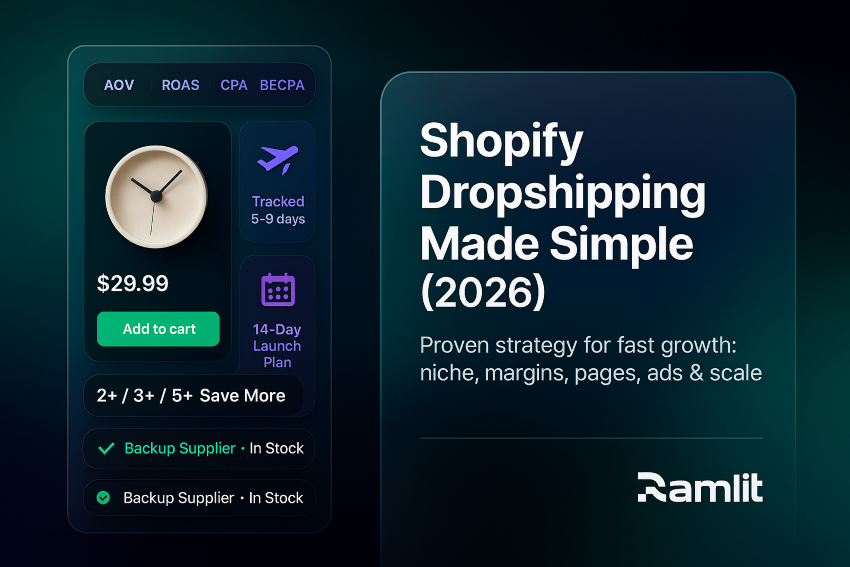The Blueprint Overview
Here’s the high-level path we’ll follow:
- Choose a buyer-led niche and product angle.
- Validate demand and delivery risk.
- Configure Shopify for speed, trust, and compliance.
- Set up suppliers, shipping, and margins.
- Publish conversion-ready product pages.
- Prepare payments, policies, and legal basics.
- Launch with a 14-day marketing plan (organic + paid).
- Track, optimize, and scale the winners.
Each step includes specific settings, checklists, and small “ship today” actions so you keep momentum.
Step 1: Pick a Buyer-Led Niche (Not Just a Product)
Most new stores start with a trending gadget. Strong stores start with a buyer segment and repeatable problems. Your niche should answer four questions:
- Who is the buyer? (e.g., new dog owners, home office professionals, beginner gardeners)
- What recurring problem do they pay to solve?
- How will the product be delivered without drama?
- Can you tell a simple story in one sentence?
Examples of buyer-led positioning:
- “Compact home-office upgrades for small apartments.”
- “Zero-mess travel accessories for parents.”
- “Beginner-friendly indoor plants and starter kits.”
This framing makes product selection easier and marketing cheaper because your store tells a coherent story.
Action today Write a one-sentence store promise: “We help [buyer] solve [problem] with [approach].”
Step 2: Validate Demand and Delivery Risk
Before you open Shopify:
- Search intent: Type seed keywords into Google (e.g., “cat travel carrier airline approved”). Look for shopping boxes, top-of-page product carousels, plural keywords (sign of commercial intent), and competing merchants.
- Price anchors: Scan major marketplaces to see common prices and bundles. You’re looking for a realistic retail price (not wishful thinking).
- Delivery sanity: Avoid fragile, oversized, battery-restricted, or obviously counterfeit categories. Prioritize products under ~2 kg with consistent supply, simple variations, and clear product standards (e.g., size charts).
Green flags
- Many long-tail queries with clear buying words (best, vs, review, where to buy).
- Video-friendly demos or before/after outcomes.
- Multiple suppliers offering similar SKUs (you have backup options).
Red flags
- Legal gray areas, trademarked phrases on the product, or safety certifications you can’t verify.
- Shipping costs that kill margins or timelines that create refund risk.
- One supplier monopoly.
Action today Shortlist 3–5 products that fit your buyer promise. Capture supplier links, cost, estimated shipping methods, and realistic retail pricing.
Step 3: Margin Math That Keeps You in Business
A clean baseline keeps you from scaling losses. Use this simple structure:
- Retail Price (R)
- Product Cost (C)
- Shipping/Transaction Fees (S)
- Marketing Cost per Order (M)
- Net Profit = R − (C + S + M)
- Profit Margin % = Net Profit / R
Rules of thumb
- Aim for 60–75% gross margin before ads (R − (C + S)) to leave room for marketing.
- Set an initial break-even CPA (cost per acquisition): BECPA = R − (C + S). If your ad CPA is under this number, you’re not losing money.
- Build a bundle or quantity break that raises AOV (average order value) 15–25% without increasing shipping complexity.
Action today Create a one-page margin sheet for each product: three retail prices, expected fees, target CPA, and AOV boosters.
Step 4: Set Up Shopify the Right Way
Core Store Settings
- Plan: Start with the basic plan; upgrade only when your processing volume justifies it.
- Domain: Use a short brand domain. Connect it immediately—trust jumps when the URL is branded.
- Payments: Enable Shopify Payments (and PayPal if available). Turn on Shop Pay for accelerated checkout.
- Checkout: Keep it one-page or express; reduce fields to essentials. Enable address auto-complete if available.
- Taxes & shipping: Configure destination markets and tax collection correctly for your region. Use transparent shipping names (e.g., “Tracked Standard 5–9 days”).
Speed & Theme
- Use a modern, lightweight Shopify theme with strong mobile performance.
- Disable unused sections and animations.
- Compress hero imagery and avoid video backgrounds on the homepage.
- Keep the homepage short: value statement, top categories, bestsellers, trust badges, and a footer with policies.
Trust & Compliance
- Publish Privacy Policy, Refund Policy, Shipping Policy, and Terms in the footer.
- Add contact methods: email and a simple contact form.
- Add a clear “Track Order” link (even if it forwards to your shipping partner’s page).
Action today Install your theme, connect the domain, configure payments, and publish policies. Keep the homepage lean; focus on getting product pages live.
Step 5: Choose and Align Suppliers
You’ll typically use one of three approaches:
-
Direct marketplace suppliers (e.g., Chinese or global B2B platforms)
- Pros: massive selection, competitive pricing.
- Cons: variable quality and timelines.
- Use when testing new products quickly.
-
Local/near-shore wholesalers or print-on-demand
- Pros: faster delivery, easier returns, better branding options.
- Cons: higher product cost.
- Use for premium positioning.
-
Private/white label (later)
- Pros: brand control, consistent margins.
- Cons: MOQs, inventory risk.
Supplier checklist
- Realistic shipping options with tracking.
- Acceptable handling time window (ideally 1–3 days).
- Responsive support with clear return policy.
- Stable product pages with consistent SKU and variant data.
- Ability to provide product assets (lifestyle images or dimensional specs).
Action today Message 2–3 suppliers per product. Ask for shipping timelines to each target region, sample availability, and packaging details.
Step 6: Publish Conversion-Ready Product Pages
Your product page is the money page. Build it like a mini landing page:
Above the Fold
- Clear product name + primary benefit (e.g., “Compact Laptop Stand — Better Posture in Small Spaces”).
- Price, stock indicator (if true), and quantity selector.
- Prominent “Add to Cart” and checkout accelerators.
- Trust signals: short shipping note (“Tracked 5–9 days”), returns summary, secure checkout icons.
Below the Fold
- Hero value block: 3–5 benefit-led bullets in plain language.
- Proof: demo GIF or photo set, short testimonials after validation, or results (e.g., “fits any 11–16 inch laptop”).
- Specs & sizing: dimensions, materials, compatibility, care instructions.
- FAQ: shipping time, returns, how to use, what’s in the box.
Media & Copy Best Practices
- Lead with benefits; support with features.
- Use short paragraphs, visual breaks, and iconography.
- Include at least one image that shows scale (handheld, on desk, on pet).
- If variations exist (size/color), auto-update imagery and SKU so carts don’t break.
Action today Publish one flagship product page to production with complete content, accurate variants, and clear shipping notes.
Step 7: Optimize Pricing, Bundles, and AOV
- Price testing: Start at your calculated retail price. Test +/- 10–15% to find the psychological sweet spot.
- Bundles: Offer “Starter,” “Pro,” and “Family/Pairs” bundles. Anchor the highest-value bundle on the right of the pricing block.
- Quantity breaks: Small discounts at 2+, 3+, 5+ units.
- Order value boosters: Gift-wrap, premium shipping, extended warranty (when meaningful), or add-on accessories that ship together.
Action today Add a 2–3 unit quantity break and a compatible accessory add-on to your flagship product.
Step 8: Essential Apps & Automations (Keep It Light)
Install only what increases conversion or saves time:
- Reviews/social proof: Import initial reviews from authorized sources or request from samples you actually sent.
- Email & SMS: Abandoned checkout, post-purchase upsell, shipping notifications.
- Upsell/cross-sell: In-cart add-ons and post-purchase one-click offers.
- Analytics: Server-side/first-party tracking where possible, plus your pixel(s).
Avoid app overload. Every app can slow your store. If an app doesn’t clearly add revenue or reduce work, skip it.
Action today Set up abandoned checkout email, “your order is on the way” notifications, and a post-purchase cross-sell for a complementary product.
Step 9: Payments, Refunds, and Policies That Reduce Chargebacks
- Payments: Offer major cards and digital wallets. Show accepted payment icons at checkout.
- Refund window: Make it clear, fair, and feasible given supplier rules.
- Shipping transparency: List tracking availability, typical windows, and how delays are handled.
- Address errors: Add a note asking customers to double-check apartment numbers and postal codes.
- Fraud filter: Enable basic fraud protection and manual review for high-risk orders.
Action today Add a short line under the Add to Cart button: “Tracked shipping • Easy 30-day returns • Secure checkout.”
Step 10: Your 14-Day Launch Plan to First Sale
This plan emphasizes speed to validation with two channels: warm organic and precise paid testing.
Days 1–3: Content & Assets
- Product photos (lifestyle + scale), 10–15 sec demo clips, simple UGC-style video with voiceover.
- Write 3 short posts showing use cases; schedule on your brand’s social profiles.
- Prepare a one-page product “cheat sheet” with benefits, specs, and competitor comparisons for creators and ad copy.
Days 4–7: Organic Seeding
- Post daily short-form content demonstrating the product in context (solve a tiny problem each video).
- Engage with niche communities (subreddits, forums, Facebook groups) by answering questions and offering value; link only when relevant.
- Offer early-bird discount to your first 20–50 customers and invite feedback.
Days 8–14: Paid Validation (Small Budget, Clear Metrics)
- Run 3–5 ad creatives (hooks) pointing to the product page.
- Use interest stacks or broad targeting depending on platform norms.
- Optimize for purchase events; monitor cost per add-to-cart, checkout, and purchase.
- Kill losers quickly (after statistically meaningful spend relative to your BECPA).
- Scale winners by 20–30% increments or duplicate into new audiences.
Targets
- Cost per add-to-cart comfortably under your BECPA.
- Landing page view-to-add-to-cart rate ≥ 5–8% for healthy intent.
- First 3–10 sales within the 14-day window.
Action today Record a 15-second demo: problem → quick use → result. Publish to your brand channels and use as ad creative.
Step 11: Post-Purchase Trust and Repeat Sales
- Thank-you page: Offer a one-click add-on (e.g., complementary accessory) at a small discount.
- Fulfillment emails: Include use tips, quick start, and an “any issues?” link to reduce refunds.
- Review request: Send after delivery with a small incentive (future discount, loyalty points) if your policies allow.
- Reactivation: 21–30 days post-purchase, send a related offer or bundle.
Action today Write a plain-language “Getting Started” email for your flagship product. Include one pro tip customers love.
Step 12: Analytics That Actually Help You Improve
Track only what you’ll act on:
- AOV, Gross Margin, CPA, ROAS, Net Profit per Order
- Landing page conversion rate (LP views → add to cart → purchase)
- Refund rate and top reasons
- Shipping times by region and method
Set weekly reviews. If profit is thin, revisit: price, AOV boosters, or switch suppliers. If conversion is weak, audit media, value proposition clarity, and page load time.
Action today Create a simple dashboard (spreadsheet or app) to input daily spend, revenue, and units sold. Add conditional coloring for BECPA.
Objection Handling: Read This Before You Overthink It
“It’s too saturated.” Crowded categories still produce wins when you niche down, position clearly, and present a better experience. The plan focuses on buyer-led positioning and fast validation.
“Shipping times will cause refunds.” Set expectations up front, use tracked methods, and pick suppliers with consistent handling. Fast communication beats silence.
“I don’t have content.” You don’t need studio polish. Use a smartphone and good lighting. Focus on outcomes and real-world context.
“Ads are expensive.” That’s why you start with organic seeding, clear BECPA, and strict kill rules. You’re buying data, not blindly spending.
Step 13: Scale What Works (Without Breaking the Store)
- Depth: Add variations, bundles, and premium versions of the winning product.
- Breadth: Introduce 1–2 complementary products that share the same buyer and promise.
- Ops: Standardize fulfillment SOPs, create canned responses for support, and implement a returns workflow.
- Branding: As volume grows, consider custom packaging inserts with care instructions and QR links to tutorials.
- Advertising: Move successful creatives into whitelisting or creator partnerships to expand reach efficiently.
Action today Write a 5-step fulfillment SOP: order sync, supplier order, tracking entry, customer email, delay handling.
Step 14: Common Mistakes to Avoid
- Launching with 10+ products and no story.
- Overloading the store with apps that slow down checkout.
- Vague shipping policies that cause disputes.
- Product pages that describe features but ignore benefits.
- Pricing that doesn’t account for fees, returns, and ad costs.
Step 15: A Simple 7-Day Quick-Start Timeline
- Day 1: Pick buyer-led promise, shortlist 3 products, message suppliers.
- Day 2: Open Shopify, connect domain, configure payments and policies.
- Day 3: Build and publish one flagship product page.
- Day 4: Record demo video, edit images, schedule 3 social posts.
- Day 5: Set up abandoned checkout and tracking. Publish quantity breaks.
- Day 6: Organic seeding in communities, collect early feedback.
- Day 7: Launch first ad set with 3–5 creatives; monitor BECPA.
Step 16: Your Launch Checklist
- [ ] Buyer promise written and displayed on homepage
- [ ] Flagship product page live with benefits, specs, and FAQ
- [ ] Payments, taxes, shipping rates, and policies configured
- [ ] Abandoned checkout and post-purchase flows active
- [ ] Tracking and analytics tested
- [ ] Supplier(s) confirmed with timelines and returns
- [ ] Demo video published; first campaign launched
Bullet Points / Quick Takeaways
- Start with a buyer-led promise, not random trending products.
- Validate for demand and delivery sanity before opening your wallet.
- Keep the store fast and focused—lean homepage, strong product pages.
- Margin math first: set a break-even CPA and AOV boosters.
- Use bundles, quantity breaks, and post-purchase offers to lift profit.
- Launch with organic seeding and small, strict paid tests.
- Track only metrics you’ll use: AOV, CPA, margin, refund rate.
- Create SOPs for fulfillment and support to protect your reputation.
- Scale depth before breadth: improve winners, then add complements.
- Consistency over complexity. Ship, measure, adjust, repeat.
Call to Action (CTA)
Ready to launch? Use this blueprint to publish your flagship product page today. Then run the 14-day plan to validate demand and make your first sale. If you’d like a tailored checklist and product-page critique, reach out and I’ll help you turn this plan into a live, converting store.
FAQ
1) How many products should I launch with? Start with one flagship product and, at most, two complementary items. A focused offer lets you polish the product page, tighten your message, and collect clean data. You can always expand once you see traction.
2) What if my supplier’s shipping is slow? Set clear expectations on the product page and in emails, choose tracked options, and keep a backup supplier on file. If delays occur, proactively message customers with new ETAs and a small goodwill credit if needed.
3) How much should I spend on ads to test a product? Use your break-even CPA as the guide. Allocate a small test budget that allows each creative to reach initial purchase data without overspending—then cut losers quickly and scale winners in controlled steps.
4) Do I need professional photos and UGC? You need clear photos that show benefits and scale. Smartphone content is fine if the lighting is good and the demo is real. UGC works because it’s believable; focus on outcome-oriented clips.
5) When should I consider private labeling or inventory? Only after you’ve proven consistent demand, positive margins, and operational stability. Start with improved packaging or inserts, then explore small MOQs for brand control once you have repeatable sales.
You have a complete, practical blueprint for launching a Shopify dropshipping store in 2026—from setup to first sale. Keep it simple, honest, and buyer-focused. Ship quickly, measure what matters, and grow what works.




